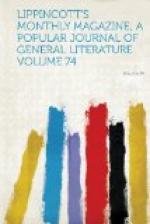M.H.
NOTES.
It is not very extraordinary that printers’ ink is a poor pigment for painting sunsets or sunrises. The strange thing is that travelers and sentimentalizers obstinately ignore the fact, and hang their paper walls with more scenery of that description than any other. What a gallery of alpine, arctic and marine sunsets we have, and how blank an impression do they all produce! From any of them, done with a clever pen by one who undertakes to describe what he has freshly seen, we gather that the spectacle must have been very fine, and must have deeply delighted the spectator. We can even catch some tints here and there, but they are fugitive, and each escapes the eye before it grasps the next one. If we shut our eyes on Tennyson’s page we may realize a glimpse of Mont Blanc blushing through “a thousand shadowy penciled valleys,” and have a momentary pleasure; but the poet’s picture does not abide with us. Some one devotes a couple of pages to mapping out the infinitude of half-tints that composed a summer’s evening view looking seaward from the North Cape—a good subject faithfully gone into, but still not a satisfactory sketch even of the reality. The pen and type will outline and shade, but cannot color. They give us some fair landscapes made up of form and effect; they can compass a cavernous bit of Rembrandt, a curtain of fog or shower, or a staircase of wood and rock climbing into the distance, just as they can sometimes faintly depict the infinite chiaroscuro of the Miserere in St. Peter’s; but the monochrome, in music as in painting, is their limit.
* * * * *




